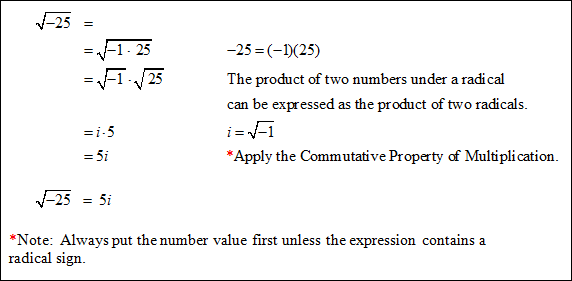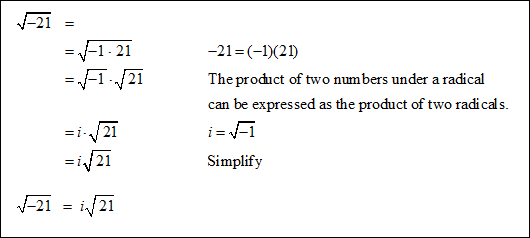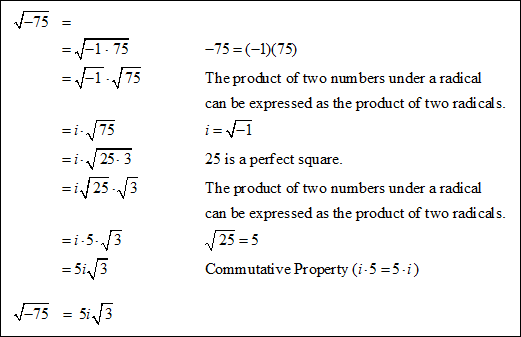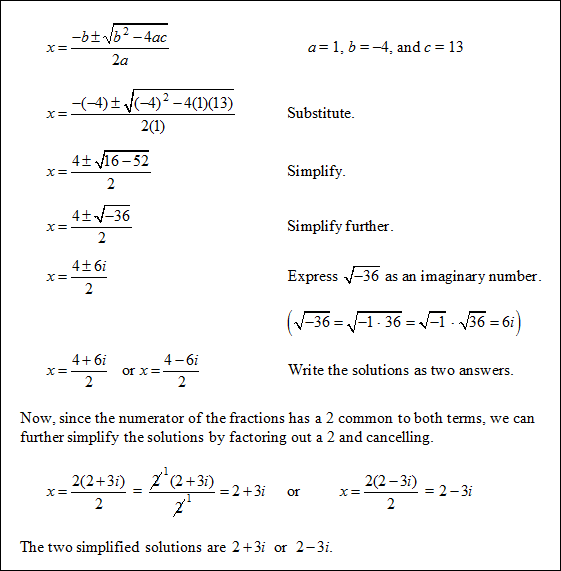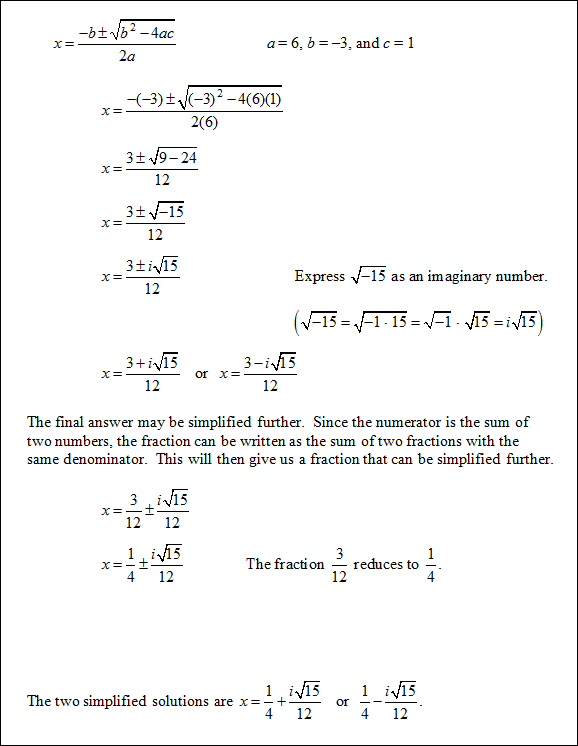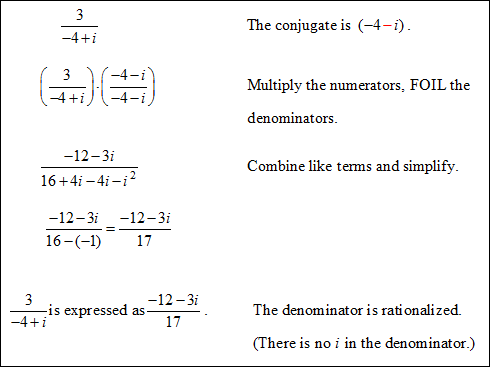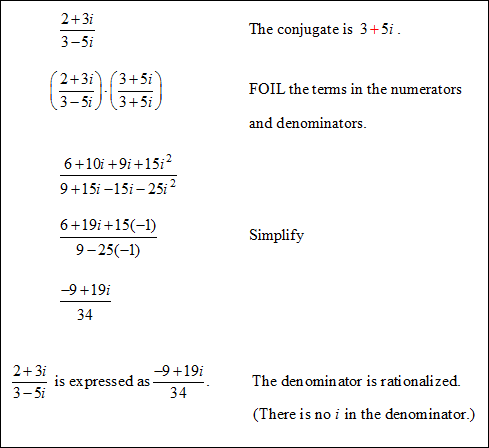COMPLEX NUMBERS

Imaginary and complex numbers are introduced in this unit. Complex numbers are extended to include the imaginary solutions of quadratic equations. The operations of complex numbers are examined including rationalizing the denominator of fractions that have radicals in the denominator
The Discriminant
The discriminant of a quadratic equation gives an idea of the number of roots and the nature of the roots of an equation. If ax2 + bx + c = 0 is the equation, then the discriminant of the equation is b2 − 4ac.
The discriminant can be seen in the quadratic formula. The discriminant is the expression under the radical, b2 − 4ac.
 |
Types of Solutions |
Example #1: Find the discriminant and determine the number of solutions for each of the quadratics shown below.
*Note: In the third quadratic equation, express the quadratic equation in standard form, 9x2 + 12x = 0, to determine a = 9, b = 12, and c = 2. |
Stop! Go to Questions #1-3 about this section, then return to continue on to the next section.
Imaginary Numbers
In dealing with the quadratic formula, sometimes the discriminant is negative. In this case, we can simplify the formula further if we know about imaginary and complex numbers.
An imaginary number is a number in the form of ai where a is any real number and i 2 = −1; thus i =
 |
When finding square root of a negative number, the first thing to do is factor out a (–1) which is equal to i.
Example #1: Simplify:
|
Example #2: Simplify:
|
Example #3: Simplify:
|
Cyclic Powers of i
The powers of i are cyclic and repeat in a pattern of 4 numbers. Thus, the powers of i have four possible outcomes.
If we continue the pattern, we have the following:
| i 5 = i 4 ⋅ i = (1)i = i |
| i 6 = i 4 ⋅ i 2 = (1)(−1) = −1 |
| i 7 = i 4 ⋅ i 3 = (1)(−i) = −i |
| i 8 = i 4 ⋅ i 4 = (1)(1) = 1 |
The table below is extended to show the cyclic pattern.
 |
Let's investigate this pattern further.
![]() What are the values of i 9, i 10, i 11, and i 12 ?
What are the values of i 9, i 10, i 11, and i 12 ?
i, –1, – i, and 1
"Click here" to check the answer.
![]() When the powers of i equal one (i 4 = 1, i 8 = 1, i 12 = 1, and so on),
When the powers of i equal one (i 4 = 1, i 8 = 1, i 12 = 1, and so on),
the exponents of i are multiples of what number?
Four
"Click here" to check the answer.
![]() What is the value of i 99 ?
What is the value of i 99 ?
i 99 = i 96 * i 3 = 1 * – i = – i
"Click here" to check the answer.
Example #4: i 26 = ?
|
Stop! Go to Questions #4-9 about this section, then return to continue on to the next section.
Complex Numbers
 |
*Two complex numbers are equal if the real parts are equal and the imaginary parts are equal.
Example #1: Solve for “x” and “y”: −3x + 4iy = 21 − 16i
|
||||||||
Now let's look at how imaginary numbers are used in finding the solutions to some quadratic equations with solutions that are expressed as complex numbers.
Example #2: Find the solution to the following quadratic: x2 − 4x + 13 = 0.
|
Example #3: Find the solution to the following quadratic: 6x2 − 3x + 1 = 0.
|
Stop! Go to Questions #10-13 about this section, then return to continue on to the next section.
Computing with Complex Numbers
| Adding and Subtracting Complex Numbers |
To add or subtract complex numbers:
| -combine the real parts -combine the imaginary parts |
Example #1: Find the sum: (−10 − 6i) + (8 − i)
|
Example #2: Find the difference: (−9 + 2i) − (3 − 4i)
|
Multiplying Complex Numbers
| Multiplying two complex numbers is accomplished in a manner similar to multiplying two binomials. You can use the FOIL process of multiplication. To multiply complex numbers in the form of a binomial times a binomial: |
| -use FOIL multiplication -combine like terms -change i 2 to (−1) |
Example #3: Find the product: (2 − i)(−3 − 4i)
|
Example #4: Find the product: (8 − 3i)(−4 + 5i)
|
In the next example, an imaginary number is multiplied by a complex number by applying the distributive property.
Example #5: Find the product: 5i(−7 −2i )
|
Stop! Go to Questions #14-21 about this section, then return to continue on to the next section.
Conjugate of a Complex Number
In order to simplify a fraction containing complex numbers, you often need to use the conjugate of a complex number. For example, the conjugate of 3 + 5i is 3 − 5i and the conjugate of 4 − 9i is 4 + 9i.
 |
To simplify a quotient with an imaginary number in the denominator, multiply by a fraction equal to 1, using the conjugate of the denominator. This is called rationalizing the denominator.
Example #1: Rationalize the denominator for the given complex number.
|
Example #2: Rationalize the denominator for the given complex number.
|
Stop! Go to Questions #22-29 to complete this unit.

